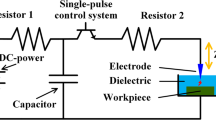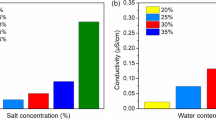Abstract
The modern industry which widely utilized sinking electrical discharge machining (EDM) with kerosene has many problems including low processing efficiency, unsafety, unfriendly environmental impact, and poor machined surface accompanying with recast layer. In this paper, a new water-in-oil (W/O) nanoemulsion dielectric is proposed to overcome these shortcomings of conventional sinking EDM. The machining performance and mechanism of sinking EDM using W/O nanoemulsion are investigated in both rough and finishing machining by comparing with kerosene. The main characteristic parameters for evaluating machining performance, including material removal rate (MRR) and relative electrode wear rate (REWR) in rough machining, and machined surface quality in finishing machining are studied. Compared with kerosene, using W/O nanoemulsion as a dielectric in sinking EDM, a nearly 34 times higher MRR and a relatively lower REWR are obtained in rough machining, and a better machined surface with no recast layer is attained in finishing machining.














Similar content being viewed by others
References
Rajeswari R, Shunmugam MS (2019) Investigations into process mechanics of rough and finish die sinking EDM using pulse train analysis. Int J Adv Manuf Technol 100(5–8):1945–1964
Qudeiri JE, Mourad AH, Ziout A, Abidi MH, Elkaseer A (2018) Electric discharge machining of titanium and its alloys. Int J Adv Manuf Technol 96(1–4):1319–1339
Leão FN, Pashby IR (2004) A review on the use of environmentally-friendly dielectric fluids in electrical discharge machining. J Mater Process Technol 149(1–3):341–346
Shabgard MR, Gholipoor A, Baseri H (2016) A review on recent developments in machining methods based on electrical discharge phenomena. Int J Adv Manuf Technol 87(5–8):2081–2097
Nguyen TD, Nguyen PH, Banh LT (2019) Die steel surface layer quality improvement in titanium μ-powder mixed die sinking electrical discharge machining. Int J Adv Manuf Technol 100(9–12):2637–2651
Peças P, Henriques E (2008) Effect of the powder concentration and dielectric flow in the surface morphology in electrical discharge machining with powder-mixed dielectric (PMD-EDM). Int J Adv Manuf Technol 37(11–12):1120–1132
Amorim FL, Dalcin VA, Soares P, Mendes LA (2017) Surface modification of tool steel by electrical discharge machining with molybdenum powder mixed in dielectric fluid. Int J Adv Manuf Technol 91(1–4):341–350
Zhao WS, Meng QG, Wang ZL (2002) The application of research on powder mixed EDM in rough machining. J Mater Process Technol 129(1–3):30–33
Wu KL, Yan BH, Lee JW, Ding CG (2009) Study on the characteristics of electrical discharge machining using dielectric with surfactant. J Mater Process Technol 209(8):3783–3789
Masuzawa T, Tanaka K, Nakamura Y, Kinoshita N (1983) Water-based dielectric solution for EDM. CIRP Ann Manuf Technol 32(1):119–122
Jeswani ML (1981) Electrical discharge machining in distilled water. Wear 72(1):81–88
Jilani ST, Pandey PC (1984) Experimetnal investigations into the performance of water as dielectric in EDM. Int J Mach Tool Des Res 24(1):31–43
Yu Z, Kunieda M (1999) Study on material removal rate of EDM in deionized water. J Jpn Soc Electr Mach Eng 33(72):28–36
Koenig W, Joerres L (1987) Aqueous solutions of organic compounds as dielectrics for EDM sinking. CIRP Ann Manuf Technol 36(1):105–109
Zeng Z, Wang Y, Wang Z, Shan D, He X (2012) A study of micro-EDM and micro-ECM combined milling for 3D metallic micro-structures. Precis Eng 36(3):500–509
Nguyen MD, Rahman M, San Wong Y (2012) Simultaneous micro-EDM and micro-ECM in low-resistivity deionized water. Int J Mach Tools Manuf 54:55–65
Nguyen MD, Rahman M, San Wong Y (2013) Transitions of micro-EDM/SEDCM/micro-ECM milling in low-resistivity deionized water. Int J Mach Tools Manuf 69:48–56
Nguyen MD, Rahman M, San Wong Y (2013) Modeling of radial gap formed by material dissolution in simultaneous micro-EDM and micro-ECM drilling using deionized water. Int J Mach Tools Manuf 66:95–101
Zhang Y, Xu Z, Zhu D, Xing J (2015) Tube electrode high-speed electrochemical discharge drilling using low-conductivity salt solution. Int J Mach Tools Manuf 92:10–18
Pan H (2014) Study of the preparation methods and properties of water-inoil (W/O) nanoemulsions using low-energy method. Shandong University.
Yeo SH, New AK (1999) A method for green process planning in electric discharge machining. Int J Adv Manuf Technol 15(4):287–291
Zhang Y, Liu Y, Ji R, Wang F, Cai B, Li H (2011) Application of variable frequency technique on electrical dehydration of water-in-oil emulsion. Colloids Surf A Physicochem Eng Asp 386(1–3):185–190
Samantray PK, Karthikeyan P, Reddy KS (2006) Estimating effective thermal conductivity of two-phase materials. Int J Heat Mass Transf 49(21–22):4209–4219
Gu L, Li L, Zhao W, Rjaurkar KP (2011) An efficient and economical rapid-tooling method for die-sinking electrical discharge machining. J Manuf Sci Eng 133(5):051004
Gu L, Li L, Zhao W, Rajurkar KP (2012) Electrical discharge machining of Ti6Al4V with a bundled electrode. Int J Mach Tools Manuf 53(1):100–106
Hasçalık A, Çaydaş U (2007) Electrical discharge machining of titanium alloy (Ti–6Al–4V). Appl Surf Sci 253(22):9007–9016
Valaki JB, Rathod PP (2016) Assessment of operational feasibility of waste vegetable oil based bio-dielectric fluid for sustainable electric discharge machining (EDM). Int J Adv Manuf Technol 87(5–8):1509–1518
Peças P, Henriques E (2009) Intrinsic innovations of die sinking electrical discharge machining technology: estimation of its impact. Int J Adv Manuf Technol 44(9–10):880–889
Haas P, Pontelandolfo P, Perez R (2013) Particle hydrodynamics of the electrical discharge machining process. Part 1: Physical considerations and wire EDM process improvement. Procedia CIRP 6:41–46
Kliuev M, Baumgart C, Büttner H, Wegener K (2018) Flushing velocity observations and analysis during EDM drilling. Procedia CIRP 77:590–593
Wang F, Liu Y, Zhang Y, Tang Z, Ji R, Zheng C (2014) Compound machining of titanium alloy by super high speed EDM milling and arc machining. J Mater Process Technol 214(3):531–538
Xu H, Gu L, Chen J, Hu J, Zhao W (2015) Machining characteristics of nickel-based alloy with positive polarity blasting erosion arc machining. Int J Adv Manuf Technol 79(5–8):937–947
Shen Y, Liu Y, Zhang Y, Dong H, Sun W, Wang X, Zheng C, Ji R (2015) High-speed dry electrical discharge machining. Int J Mach Tools Manuf 93:19–25
Shen Y, Liu Y, Sun W, Zhang Y, Dong H, Zheng C, Ji R (2016) High-speed near dry electrical discharge machining. J Mater Process Technol 233:9–18
Xia H, Kunieda M, Nishiwaki N (1996) Removal amount difference between anode and cathode in EDM process. IJEM 1:45–52
Marafona J (2007) Black layer characterisation and electrode wear ratio in electrical discharge machining (EDM). J Mater Process Technol 184(1–3):27–31
Kunieda M, Kobayashi T (2004) Clarifying mechanism of determining tool electrode wear ratio in EDM using spectroscopic measurement of vapor density. J Mater Process Technol 149(1–3):284–288
Funding
The work is partially supported by the Fundamental Research Funds for the Central Universities (Grant No. 16CX06016A), the Graduate Innovation Project of China University of Petroleum (East China) (Grant No. YCXJ2016058), the Key Pre-Research Foundation of Military Equipment of China (Grant No. 6140923030702), and the National Natural Science Foundation of China (Grant No. 51774316).
Author information
Authors and Affiliations
Corresponding author
Additional information
Publisher’s note
Springer Nature remains neutral with regard to jurisdictional claims in published maps and institutional affiliations.
Rights and permissions
About this article
Cite this article
Dong, H., Liu, Y., Liu, T. et al. Water-in-oil nanoemulsion dielectric for both rough and finishing electrical discharge machining. Int J Adv Manuf Technol 104, 1485–1495 (2019). https://doi.org/10.1007/s00170-019-04028-y
Received:
Accepted:
Published:
Issue Date:
DOI: https://doi.org/10.1007/s00170-019-04028-y




